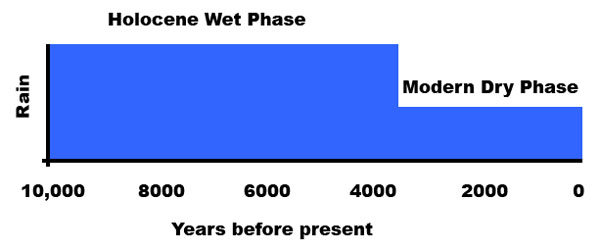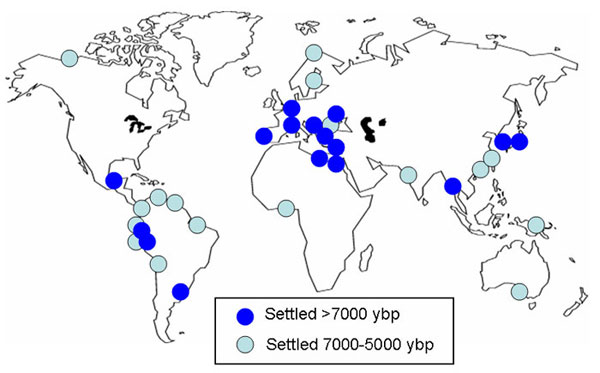Holocene Wet Phase
The following diagram shows at a very coarse scale some changes in climate that have occurred over the past 10,000 years. In this course, we use rainfall as a proxy for climate because we don't have any temperature records. The term "Holocene" refers to the most recent 10,000 years, following the last glacial epoch. This time period corresponds to the melting of the glacial ice that covered Canada and Scandinavia and made the Great Lakes and the Finger Lakes in the northern US. In Africa, this date marks the official start of the modern Nile. The river we recognize today was established as the Wet Phase brought good rainfall in the source areas. At that time much of the Sahara was covered by green landscape, and the Nile was fairly inconsequential in social terms. There was plenty of rain in the Sahara, so nobody needed the Nile.
The Holocene Wet Phase lasted for more than 6500 years, until middle of 4th millennium BC (about 3500 BC, 5500 years ago), when the amount of rain falling dropped dramatically. Desert formed both east and west of the Nile, and Egypt first developed its familiar sand dunes.

10,000 years of climate change. Source: From the personal collection of Dr. Laura Guertin.
In fact, the Nile delta didn't even exist at the start of the Holocene Wet Phase. The following image shows the number and diversity of deltas where civilizations began. All of these deltas developed after - and as a direct consequence of - the melting of the ice sheets. Once the ice started to melt, it formed rivers, which carried dirt to the ocean. This dirt (sediment) formed deltas, one of which was the Nile Delta. As you can see on this slide, during the period between 8500-6500 years ago two things happened simultaneously: (a) deltas developed and (b) people settled on them. Studies of the Nile and the Yangtze deltas show that they were occupied as early as ~7500 years ago (5500 BC). The first humans settled on the delta within 500 years of the initial stable fertile plain. So - the ice melted, the deltas formed, people moved there.

Distribution and Settlement of Holocene Deltas. Source: Modified after Stanley & Warne from "Holocene sea-level change and early human utilization of deltas," GSA Today, vol. 7, no. 12, p. 1.
Why did people go to the deltas? Two reasons:
- Deltas are great places to live. You have fresh water, good soil, access to trade across the ocean, and the ability to see approaching friends or foes.
- The Sahara started to dry up and folks needed water.
In other words—if there hadn't been any climate change in the past 10,000 years, there would be neither deltas nor civilization. This triad works together.